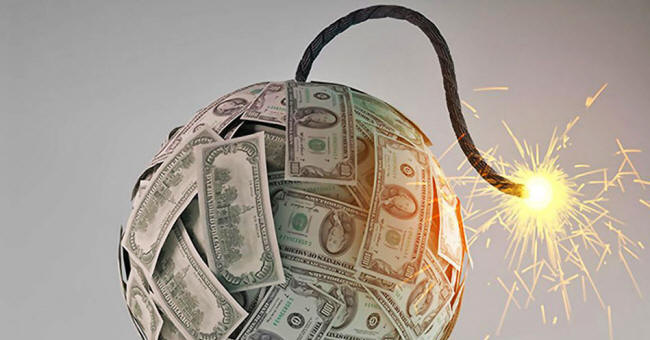|

by Justin
July 12,
2018
from
BitGuru Website
Spanish version

You may well have seen in the news the last couple of days that
global debt has reached another all time high.
After climbing to an
astonishing $247 trillion when combining public debt of
around $60 trillion and non-financial sector debt of
about $186 trillion.
This eye watering figure
also means that for the first time ever there is now officially 3
times more debt in the world than money...
It has been reported that this astounding level of debt is causing
major cause by investors on top of ongoing concerns about the
Federal Reserve's monetary policy.
Is the global
economy coming to an end?
According to the CIA, the total amount is $80 trillion if you
include "broad money."
Broad money its not
exactly physical cash but rather accessible cash so things such as
checking accounts, savings accounts, money-market accounts.
Anything which is not
considered physical but you can make a bank transaction digitally
and use that as money.
If you include this figure then total estimated value of all the
money in the world is $80 trillion. The figures pales into
insignificance when compared to the aforementioned global debt
figures.
3 Times More Debt in the World than Money
CNBC and
Bloomberg have reported the news of
this increase in global debt figures, it is also claimed that this
figure has rose $29 trillion since 2016.
Meaning for the first
time ever there is 3 times more debt in the world than money.
How can there be more
debt than money?
When banks hold your money, they understand that only a small
fraction of people will need to withdraw their money at any one
time.
Because of this, the
banks are able to loan out up to 90% the money they have on deposit
to other parties. This process is called Fractional Reserve banking
and has been going on for centuries.
If too many people try to withdraw their money at the same time, the
system would collapse like what happened in the Great Depression,
where many banks were forced to shut down.
"The term fractional
reserve refers to the fraction of deposits held in reserves.
For example, if a
bank has $500 million in assets, it must hold $50 million, or
10%, in reserves. Analysts reference an equation referred to as
the multiplier equation when estimating the impact of the
reserve requirement on the economy as a whole.
The equation provides
an estimate for the amount of money created with the fractional
reserve system.
The estimate is
calculated by multiplying the initial deposit by one divided by
the reserve requirement. So, using the example, the calculation
is $500 million multiplied by one divided by 10%, or $5 billion.
It should be noted
that this is not how money is actually created. It is only a way
to represent the possible impact of the fractional reserve
system on the money supply.
As such, while is
useful for economics teachers, it is generally regarded as an
oversimplification by policymakers."
Investopedia
Fractional reserve banking
basically means that more debt can be created, based upon the
assumption that on a minority of people will ever withdraw their
savings as the same time.
The amount of new debt
created is constantly being compounded because the new money lent
out, is deposited back into banks which can then be lent out again.
Each time created more
debt in the form of interest on top.
How long can
the system be sustained?
Fractional reserve banking has been essential for the growth of the
global economy.
Without it we wouldn't
have much of the technology, infrastructure and general good
standard of living as we do today. It's a well oiled machine at the
moment and has been running without many hiccups for the past
century.
However many speculate
that the system cannot be sustained forever.
The amount of debt in the world is only expected to continue
climbing, and at an even faster pace.
How long can it be
sustained...?
|


